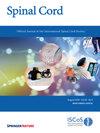腹部功能性电刺激对高位脊髓损伤患者血压的影响。
IF 2.1
4区 医学
Q3 CLINICAL NEUROLOGY
引用次数: 0
摘要
研究设计单中心训练研究:调查一组脊髓损伤(SCI)患者在咳嗽训练中腹部肌肉经皮功能性电刺激(腹部FES)对血压(BP)的影响,以及血压受损伤特征的影响和随时间的变化:环境:实验室和社区:方法:16 名患有 SCI(C4-T5)的参与者在 6 周内接受了 25 次腹部 FES 咳嗽训练(5 组 10 次刺激性咳嗽),这是之前发表的腹部 FES 训练对咳嗽影响研究的一部分。每组训练结束后测量收缩压(SBP)、舒张压(DBP)和计算出的平均动脉压(MAP):结果:腹部 FES 咳嗽使几乎所有参与者的血压从最初的静息血压平均急剧升高约 30%(p 结论:腹部 FES 咳嗽使血压从最初的静息血压平均急剧升高约 30%(p):咳嗽训练中经皮腹部外展电刺激可使血压急剧升高。然而,训练 25 次后,血压升高的幅度会减小。腹部外展电刺激可能是对抗正性低血压的一种解决方案,但其效果可能会随着时间的推移而减弱。本文章由计算机程序翻译,如有差异,请以英文原文为准。

The effect of abdominal functional electrical stimulation on blood pressure in people with high level spinal cord injury
Single centre training study. To investigate, in a group of people with spinal cord injury (SCI), the effect of transcutaneous functional electrical stimulation of the abdominal muscles (abdominal FES) during cough training on blood pressure (BP), and how it is affected by injury characteristics and alters over time. Laboratory and community. Sixteen participants with SCI (C4-T5) underwent 25 of abdominal FES cough training (5 sets of 10 stimulated coughs) over 6 weeks as part of a previously published study on the effect of abdominal FES training on cough. Systolic BP (SBP), diastolic BP (DBP) and calculated mean arterial pressure (MAP) were measured at the completion of each set. Abdominal FES coughing resulted in an average ~30% acute increase in BP from initial resting BP across all sessions in almost all participants (p < 0.001). However, the increase in BP during abdominal FES coughs from rest reduced over the 25 sessions of training by ~35% for SBP, MAP and DBP (p = 0.024, p = 0.013 and p = 0.042, respectively). There was no meaningful change in resting BP over time (p = 0.935, p = 0.705 and p = 0.988, respectively). Overall, increases in BP during abdominal FES coughs were greatest for those with chronic injuries and cervical injuries. Transcutaneous abdominal FES during cough training acutely increases BP. However, the magnitude of the increase is reduced after 25 sessions of training. Abdominal FES may offer a solution to combat orthostatic hypotension, but its effectiveness may diminish over time.
求助全文
通过发布文献求助,成功后即可免费获取论文全文。
去求助
来源期刊

Spinal cord
医学-临床神经学
CiteScore
4.50
自引率
9.10%
发文量
142
审稿时长
2 months
期刊介绍:
Spinal Cord is a specialised, international journal that has been publishing spinal cord related manuscripts since 1963. It appears monthly, online and in print, and accepts contributions on spinal cord anatomy, physiology, management of injury and disease, and the quality of life and life circumstances of people with a spinal cord injury. Spinal Cord is multi-disciplinary and publishes contributions across the entire spectrum of research ranging from basic science to applied clinical research. It focuses on high quality original research, systematic reviews and narrative reviews.
Spinal Cord''s sister journal Spinal Cord Series and Cases: Clinical Management in Spinal Cord Disorders publishes high quality case reports, small case series, pilot and retrospective studies perspectives, Pulse survey articles, Point-couterpoint articles, correspondences and book reviews. It specialises in material that addresses all aspects of life for persons with spinal cord injuries or disorders. For more information, please see the aims and scope of Spinal Cord Series and Cases.
 求助内容:
求助内容: 应助结果提醒方式:
应助结果提醒方式:


